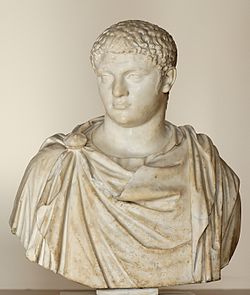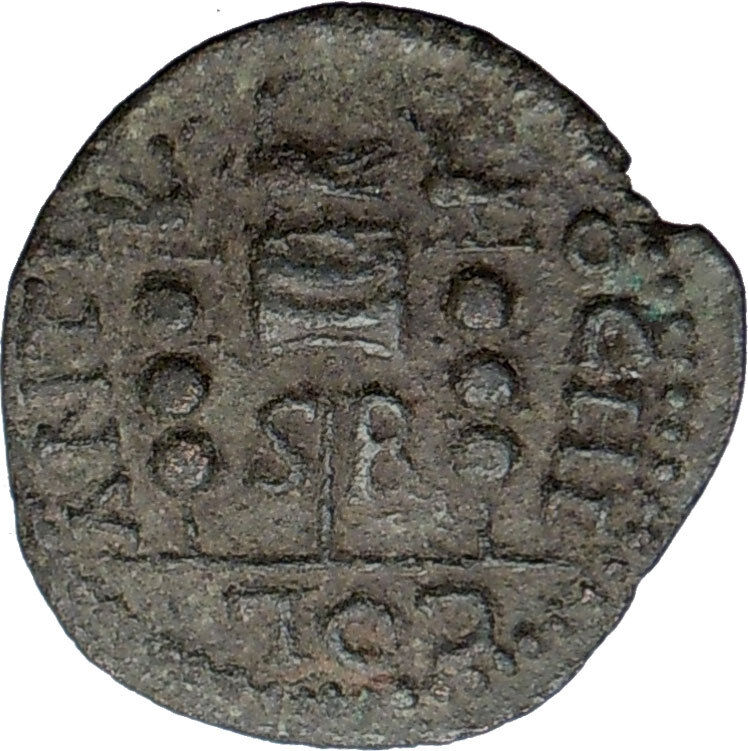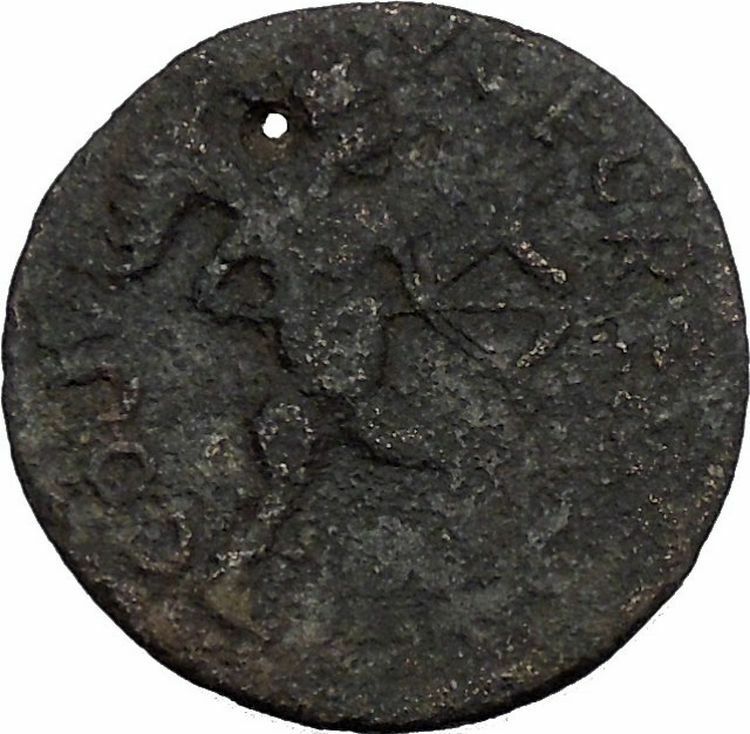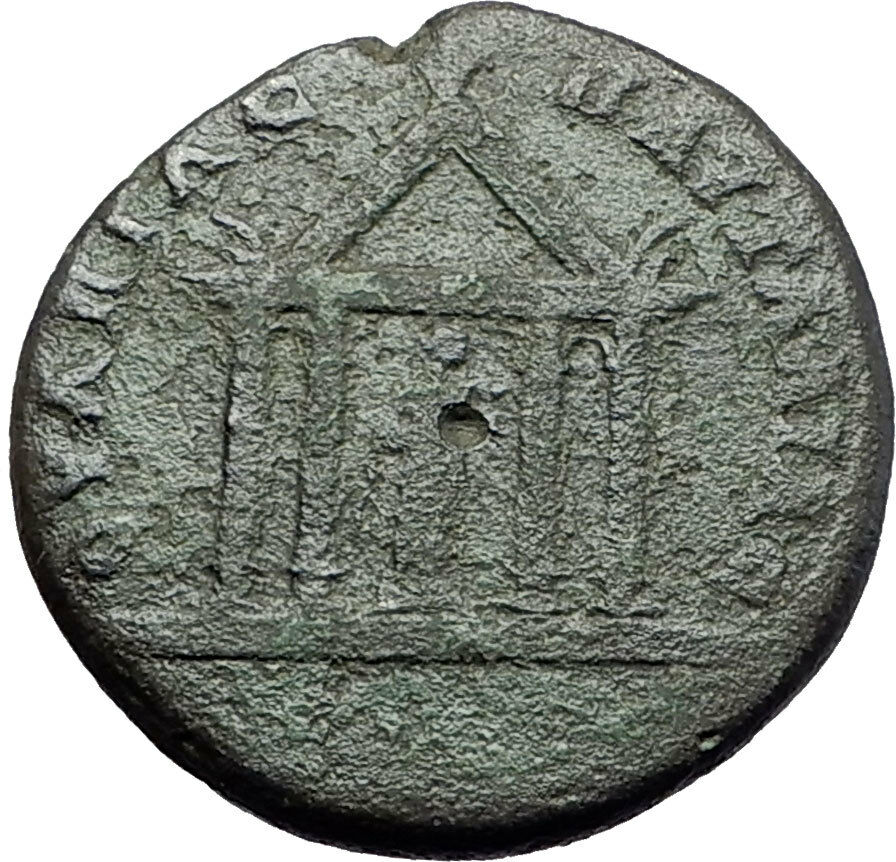|
Geta – Roman Emperor: 209-211 A.D.
CITY FOUNDING OXEN TYPE
Bronze 34mm of Antiochia in Pisidia Struck circa 209-211 A.D.
Reference: Krzyzanowska XVII, 49 (Caracalla); SNG BnF 1187.
Certification: NGC Ancients
VF 5872351-015
IMP CAES P SEPT GETA AVG, laureate head right.
CAE ANTIOCH, priest plowing right with two oxen (city foundation pomerium scene); S R in exergue..
You are bidding on the exact item pictured, provided with a Certificate of Authenticity and Lifetime Guarantee of Authenticity.
Symbolism of Man Plowing with Oxen as Birth of a Roman City
On first look, the priest or colonist with a plow looks a like a very unimposing scene. However, it is far from it as it alludes to the founding of a new colony. From the time of the Roman emperor Augustus, at least you have a rapidly expanding empire and new colonies or otherwise known as cities were established around the frontiers. There would sometimes be veteran soldiers settled in these colonies with grants of land on retirement. The plow breaking new sod gives the symbolism of driving back the wilderness and domesticating the land.
The distance that an a man with a plow and two oxen could plow before the oxen needed to rest was approximately 120 feet. This was originally used for farm land measurements, to approximate yields of a crop as an example. Because of the practicality of this measurement, this standard was used in plotting new cities, not just for farming. When founding a city, a 120 by 240 foot land measurement was called an iugerum. How this was arrived at was the plowing in one direction of 120 feet, then another direction for 120 feet, creating 120 by 120 foot section called an actus. When you put these two sections side by side you got the iugerum.
The iconography of the priest or colonist with a plow and oxen is used widely on Roman Provincial, also known as Greek Imperial coins and is an interesting subject to study and collect all on it’s own.
The pomerium or pomoerium was a religious boundary around the city of Rome and cities controlled by Rome. In legal terms, Rome existed only within its pomerium; everything beyond it was simply territory (ager) belonging to Rome.
Name
The term is a classical contraction of the Latin phrase post moerium, literally “behind the wall”. The Roman historian Livy writes in his Ab Urbe Condita that, although the etymology implies a meaning referring to a single side of the wall, the pomerium was originally an area of ground on both sides of city walls. He states that it was an Etruscan tradition to consecrate this area by augury and that it was technically unlawful to inhabit or to farm the area of the pomerium, which in part had the purpose of preventing buildings from being erected close to the wall (although he writes that, in his time, houses were in fact built against the wall).
Location and extensions
Tradition maintained that the pomerium was the original line ploughed by Romulus around the walls of the original city, and that it was inaugurated by Servius Tullius. The legendary date of its demarcation, 21 April, continued to be celebrated as the anniversary of the city’s founding.
The pomerium did not follow the line of the Servian walls, and remained unchanged until the Dictator Lucius Cornelius Sulla, in a demonstration of his absolute power, expanded it in 80 BC. Several white marker stones (known as cippi) commissioned by Claudius have been found in situ and several have been found away from their original location. These stones mark the boundaries and relative dimensions of the pomerium extension by Claudius. This extension is recorded in Tacitus and outlined by Aulus Gellius.
 Inscription marking the Claudian pomerium in via del Pellegrino Inscription marking the Claudian pomerium in via del Pellegrino
The pomerium was not a walled area (unlike the Chinese Forbidden City), but rather a legally and religiously defined one marked by cippi. It encompassed neither the entire metropolitan area nor even all the Seven Hills (the Palatine Hill was within the pomerium, but the Capitoline and Aventine Hills were not). The Curia Hostilia and the well of the Comitium in the Forum Romanum, two extremely important locations in the government of the city-state and its empire, were located within the pomerium. The Temple of Bellona was beyond the pomerium.
Associated restrictions
- The magistrates who held imperium did not have full power inside the pomerium. They could have a citizen beaten, but not sentenced to death. This was symbolised by removing the axes from the fasces carried by the magistrate’s lictors. Only a dictator’s lictors could carry fasces containing axes inside the pomerium.
- It was forbidden to bury the dead inside the pomerium. During his life, Julius Caesar received in advance the right to a tomb inside the pomerium, but his ashes were actually placed in his family tomb. However, Trajan’s ashes were interred after his death in AD 117 at the foot of his Column, which was within the pomerium.
- Provincial promagistrates and generals were forbidden from entering the pomerium, and resigned their imperium immediately upon crossing it (as it was the superlative form of the ban on armies entering Italy). Ceremonies of triumph, in which an army would march through the city in celebration of a victory, were an exception to this rule, although a general could only enter the city on the very day of his triumph, and would be required to wait outside the pomerium with his troops until that moment. Under the Republic, soldiers also lost their status when entering, becoming citizens: thus soldiers at their general’s triumph wore civilian dress. The Comitia Centuriata, one of the Roman assemblies, consisting of centuriae (voting units, but originally military formations within the legions), was required to meet on the Campus Martius outside the pomerium.
- Pompey’s Theatre, where Julius Caesar was murdered, was outside the pomerium and included a chamber where the Senate could meet allowing the attendance of any senators who were forbidden to cross the pomerium and thus would not have been able to meet in the Curia Hostilia.
- Weapons were prohibited inside the pomerium. Praetorian guards were allowed in only in civilian dress (toga), and were then called collectively cohors togata. But it was possible to sneak in daggers (the proverbial weapon for political violence; see sicarius). Since Julius Caesar’s assassination occurred outside this boundary, the senatorial conspirators could not be charged with sacrilege for carrying weapons inside the sacred city.
See also

Geta – Roman Emperor: 209-211 A.D.
| Caesar: 198-209 A.D. (under Septimius Severus and Caracalla) | Augustus: 209-211 A.D. (209-211 with Septimius Severus and Caracalla) (211 A.D. with Caracalla) |
| Son of Septimius Severus and Julia Domna | Brother of Caracalla | Brother-in-law of Plautilla | Nephew of Julia Maesa | Cousin of Julia Soaemias and Julia Mamaea |
Publius Septimius Geta (March 7, 189-December 26, 211), was a Roman Emperor co-ruling with his father Septimius Severus and his older brother Caracalla from 209 to his death.
Geta was the younger son of Septimius Severus by his second wife Julia Domna. Geta was born in Rome, at a time when his father was only a provincial governor at the service of emperor Commodus.
Geta was always in a place secondary to his older brother Lucius, the heir known as Caracalla. Perhaps due to this, the relations between the two were difficult from their early years. Conflicts were constant and often required the mediation of their mother. To appease his youngest son, Septimius Severus gave Geta the title of Augustus in 209. During the campaign against the Britons of the early 3rd century, the imperial propaganda publicized a happy family that shared the responsibilities of rule. Caracalla was his father’s second in command, Julia Domna the trusted counsellor and Geta had administrative and bureaucratic duties. Truth was that the rivalry and antipathy between the brothers was far from being improved.
Joint Emperor
When Septimius Severus died in Eboracum in the beginning of 211, Caracalla and Geta were proclaimed joint emperors and returned to Rome.
Regardless, the shared throne was not a success: the brothers argued about every decision, from law to political appointments. Later sources speculate about the desire of the two of splitting the empire in two halves. By the end of the year, the situation was unbearable. Caracalla tried to murder Geta during the festival of Saturnalia without success. Later in December he arranged a meeting with his brother in his mother’s apartments, and had him murdered in her arms by centurions.
Following Geta’s assassination, Caracalla damned his memoryy and ordered his name to be removed from all inscriptions. The now sole emperor also took the opportunity to get rid of his political enemies, on the grounds of conspiracy with the deceased. Cassius Dio stated that around 20,000 persons of both sexes were killed and/or proscribed during this time.
|








 Inscription marking the Claudian pomerium in via del Pellegrino
Inscription marking the Claudian pomerium in via del Pellegrino 





